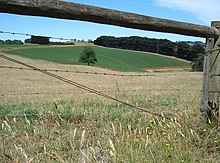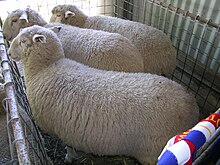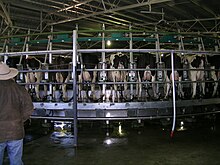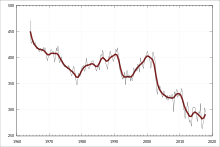Agriculture in Australia


Although Australia is mostly arid, the nation is a major agricultural producer and exporter, with over 325,300 employed in agriculture, forestry and fishing as of February 2015.[1] Agriculture and its closely related sectors earn $155 billion-a-year for a 12% share of GDP. Farmers and grazers own 135,997 farms, covering 61% of Australia's landmass.[2] Across the country there is a mix of irrigation and dry-land farming. Australia leads the world with 35 million hectares certified organic, which is 8.8% of Australia's agricultural land[3] and Australia now accounts for more than half (51%) of the world's certified organic agriculture hectares.[4] The success of Australia to become a major agricultural power despite the odds is facilitated by its policies of long-term visions and promotion of agricultural reforms that greatly increased the country's agricultural industry.[5]
The CSIRO, the federal government agency for scientific research in Australia, has forecast that climate change will cause decreased precipitation over much of Australia and that this will exacerbate existing challenges to water availability and quality for agriculture.[6]


There are three main zones: the high rainfall zone of Tasmania and a narrow coastal zone (used principally for dairying and beef production); wheat, sheep zone (cropping (principally winter crops), and the grazing of sheep (for wool, lamb and mutton) plus beef cattle) and the pastoral zone (characterised by low rainfall, less fertile soils, and large scale pastoral activities involving the grazing of beef cattle and sheep for wool and mutton).[7] An indicator of the viability of agriculture in the state of South Australia is whether the land is within Goyder's Line.
History[]
This section needs expansion. You can help by . (August 2021) |
Production[]
Australia's main agricultural products are very contrasting crops: sugar cane (typical of tropical countries), wheat and barley (typical of cold countries). In 2018, Australia was the world's largest producer of lupin bean (714 thousand tons), the world's second largest producer of chickpeas (1 million tons), the world's fourth largest producer of barley (9.2 million tons) and oats (1.2 million tons), the 5th largest producer of rapeseed (3.9 million tons), the 9th largest producer of sugarcane (33.5 million tons) and wheat (20.9 million tons) and the 13th largest world producer of grape (1.66 million tons). In the same year, the country also produced 1.2 million tons of sorghum, 1.1 million tons of potato, in addition to smaller productions of other agricultural products, such as rice (635 thousand tons), maize (387 thousand tons), tomato (386 thousand tons), orange (378 thousand tons), fava beans (377 thousand tons), banana (373 thousand tons), pea (317 thousand tons), carrot (284 thousand tons), onion (278 thousand tons), apple (268 thousand tons), lentils (255 thousand tons), melon (224 thousand tons), watermelon (181 thousand tons), tangerine (138 thousand tons) etc.[8]
Major agricultural products[]
Australia produces a large variety of primary products for export and domestic consumption. The forecast top ten agricultural products by value are listed for the year 2006–07, with production figures from previous years.[9]
| Commodity (in millions of AUD$) | 2001-02 | 2002-03 | 2003-04 | 2004-05 | 2005-06 | 2006-07 |
|---|---|---|---|---|---|---|
| Cattle and calves | 6,617 | 5,849 | 6,345 | 7,331 | 7,082 | 6,517 |
| Wheat | 6,356 | 2,692 | 5,636 | 4,320 | 5,905 | 6,026 |
| Milk | 3,717 | 2,795 | 2,828 | 3,808 | 3,268 | 3,245 |
| Fruit and nuts | 2,333 | 2,408 | 2,350 | 2,640 | 2,795 | 2,915 |
| Vegetables | 2,269 | 2,126 | 2,356 | 2,490 | 2,601 | 2,715 |
| Wool | 2,713 | 3,318 | 2,397 | 2,196 | 2,187 | 2,138 |
| Barley | 1,725 | 984 | 1,750 | 1,240 | 1,744 | 1,624 |
| Poultry | 1,175 | 1,273 | 1,264 | 1,358 | 1,416 | 1,461 |
| Lamb | 1,181 | 1,161 | 1,318 | 1,327 | 1,425 | 1,348 |
| Sugar cane | 989 | 1,019 | 854 | 968 | 1,037 | 1,208 |
Crops[]


Cereals, oilseeds and grain legumes are produced on a large scale in Australia for human consumption and livestock feed. Wheat is the cereal with the greatest production in terms of area and value to the Australian economy. Sugarcane, grown in tropical Australia, is also an important crop; however, the unsubsidised industry (while lower-cost than heavily subsidised European and American sugar producers) is struggling to compete with the huge and much more efficient Brazilian sugarcane industry.[10]
Horticulture[]

In 2005 McDonald's Australia Ltd announced it would no longer source all its potatoes for fries from Tasmanian producers and announced a new deal with New Zealand suppliers. Subsequently, Vegetable and Potato Growers Australia (Ltd.) launched a political campaign advocating protectionism.[11]
Viticulture[]

Although the Australian wine industry enjoyed a large period of growth during the 1990s, over planting and oversupply led to a large drop in the value of wine, forcing out of business some winemakers, especially those on contracts to large wine-producing companies. At the time, the future for some Australian wine producers seemed uncertain, but by 2015 a national study showed that the industry had recovered and the combined output of grape growing and winemaking were major contributors to the Australian economy's gross output[12] while the associated industry of wine tourism had also expanded.[13] A follow-up report from 2019 demonstrated further consolidation, by which stage wine had become Australia's fifth-largest agricultural export industry with domestic and international sales contributing AU$45.5 billion to gross output.[14]

Animal products[]
Beef industry[]
The beef industry is the largest agricultural enterprise in Australia, and it is the second largest beef exporter, behind Brazil, in the world. All states and territories of Australia support cattle breeding in a wide range of climates. Cattle production is a major industry that covers an area in excess of 200 million hectares. The Australian beef industry is dependent on export markets, with over 60% of Australian beef production exported, primarily to the United States, Korea and Japan.[15]

In southern Australia (NSW, Victoria, Tasmania, South Australia and south-western Western Australia) beef cattle are often reared on smaller properties as part of a mixed farming or grazing operation, but some properties do specialise in producing cattle. The southern calves are typically reared on pasture and sold as weaners, yearlings or as steers at about two years old or older.[16] Artificial insemination and embryo transfer are more commonly used in stud cattle breeding in Australia, but may be used in other herds.[17]
In the Top End, sub-tropical areas and in arid inland regions cattle are bred on native pastures on expansive cattle stations. Anna Creek Station in South Australia, Australia is the world's largest working cattle station.[18] The North Australian Pastoral Company Pty Limited (NAPCO) is now one of Australia's largest beef cattle producers, with a herd of over 180,000 cattle and fourteen cattle stations in Queensland and the Northern Territory.[19] The Australian Agricultural Company (AA Co) manages a cattle herd of more than 585,000 head.[20] Heytesbury Beef Pty Ltd owns and manages over 200,000 head of cattle across eight stations spanning the East Kimberley, Victoria River and Barkly Tablelands regions in Northern Australia.[21]
Prior to European settlement there were no cattle in Australia. The present herd consists principally of British and European breeds (Bos taurus), in the southern regions with Aberdeen Angus and Herefords being the most common. In northern Australia Bos indicus breeds predominate along with their crosses. They were introduced to combine the resistance to cattle ticks and greater tolerance of hot weather.[22]
Despite strong public opposition (a petition carrying 200,000 signatures of people opposed to live export was tabled in parliament[23])and opposition from the RSPCA because of cruelty, the export of live cattle continues.[24]

Pork industry[]

Dairy[]

Domestic milk markets were heavily regulated until the 1980s, particularly for milk used for domestic fresh milk sales. This protected smaller producers in the northern states who produced exclusively for their local markets. The Kerin Plan (named after politician John Kerin) began the process of deregulation in 1986. The final price supports were removed in 2000 with the assistance of Pat Rowley, head of the Australian Dairy Farmers Federation and the Australian Dairy Industry Council.[25] Deregulation ultimately saw 13,000 Australian dairy farmers produce 10 billion litres of milk in comparison to the 5 billion litres of milk produced by 23,000 farmers prior to deregulation,[26] a 30% reduction in farmers with a 55% rise in milk production.[27] As the Australian dairy industry grows feedlot systems are becoming more popular.[28][29]
Fisheries[]

The fisheries in Australia is a very large scale industry. Australia produces many species of fish including farmed, sustainable and intensive and wild caught such as tuna and other schooling fish.
Wool[]

Animal rights organisations including PETA are currently promoting a boycott of Australian, and all Merino wool, as a protest against the practice of mulesing, a procedure used to prevent the animals from becoming fly blown with maggots.[30] In 2004, due to the worldwide attention, AWI proposed to phase out the practice by the end of year 2010; this promise was retracted in 2009.[31]
Seaweeds[]
The shorelines, especially the Great Barrier Reef, are providing motivation to help the continent by using seaweed (algae) to absorb nutrients.[32] Because of the giant number of natural Australian seaweeds,[33] not only could seaweed cultivation be used to help absorb nutrients around the GBR and other Australian shores, cultivation could also help feed a large part of the world.[34][35][36] Even the Chinese, who could be considered far more advanced in seaweed cultivation, are interested in the future of Australian seaweeds.[37] Lastly, the GBR itself, because of the delicate corals,[38] has lent itself to utilizing seaweed/algae purposely as a nutrient reduction tool in the form of algae.[39]
Olives[]
Olives have been grown in Australia since the early 1800s.[40] Olive trees were planted by the warden of the self-funded penal settlement on St Helena Island, Queensland in Moreton Bay.[41] By the mid-90s there were 2,000 hectares (4,900 acres) and from 2000 to 2003 passed 20,000 hectares (49,000 acres). By 2014 (Ravetti and Edwards, 2014) there were 2000 plantations, covering over 35,000 hectares (86,000 acres), and producing 93,500 tonnes (92,000 long tons; 103,100 short tons) of olives. 3,000 tonnes (3,000 long tons; 3,300 short tons) used as table olives and around 5–7,000 tonnes (4.9–6,889.4 long tons; 5.5–7,716.2 short tons) exported to the United States, China, the European Union, New Zealand and Japan. Between 2009 and 2014 Australia imported an average of 31,000 tonnes (31,000 long tons; 34,000 short tons) predominantly from Spain, Italy and Greece.[42] China olive oil consumption is increasing and Chinese investors have begun to buy Australian olive farms.[43][44] Olive cultivars include Arbequina, Arecuzzo, Barnea, Barouni, Coratina, Correggiola, Del Morocco, Frantoio, Hojiblanca, Jumbo Kalamata, Kalamata, Koroneiki, Leccino, Manzanillo, Pendulino, Picholine, Picual, Sevillano, UC13A6, and Verdale. Manzanillo, Azapa, Nab Tamri and South Australian Verdale for the production of table olives.[45]
Importance of irrigation[]
Because of Australia's large deserts and irregular rainfall, irrigation is necessary for agriculture in some parts of the country. The total gross value of irrigated agricultural production in 2004-05 was A$9,076 million compared to A$9,618 million in 2000–01. The gross value of irrigated agricultural production represents around a quarter (23%) of the gross value of agricultural commodities produced in Australia in 2004–05, on less than 1% of agricultural land.[46]
Of the 12,191 GL of water consumed by agriculture in 2004–05, dairy farming accounted for 18% (2,276 GL), pasture 16% (1,928 GL), cotton 15% (1,822 GL) and sugar 10% (1,269 GL).[46]
Issues facing Australian agriculture[]
Political values[]
Historian F.K. Crowley finds that:
- Australian farmers and their spokesman have always considered that life on the land is inherently more virtuous, more healthy, more important and more productive, than living in the towns and cities. The farmers complained that something was wrong with an electoral system which produced parliamentarians who spent money beautifying vampire-cities instead of developing the interior.[47]
The Country Party, from the 1920s to the 1970s, promulgated its version of agrarianism, which it called "countrymindedness". The goal was to enhance the status of the graziers (operators of big sheep ranches) and small farmers and justified subsidies for them.[48]

Technical, environmental and economic issues[]
The agricultural industry is one of the most trade-exposed sectors of the Australian economy.[49]
Genetic modification[]
GM (genetically modified) grains are not allowed in South Australia, where some grain producers have called for the moratorium to be lifted. They argue the GM technology would help them tackle weeds and other pests, and that farmers should be able to choose how they run their enterprises and whether or not they wanted to grow the "premium products" described by Leon Bignell, the South Australian (SA) Agriculture Minister. Producers have also said their GM-free grain is not translating to higher profits. Bignell conceded more work needed to be done to market produce as GM-free but said he was confident producers would see higher financial returns in the near future. In March 2015, Bignell told farmers they should not use GM but should instead rely upon what he called 'God's gifts'.[50] He said the "amazing" results of the Government's "New Horizons" soil improvement program "prove", in his view, that grain producers "do not need genetic modification technology". He said that "Instead of using the top five centimetres of the soil, you go down to 50 cm or even deeper. You put clay in it when it's needed, you put organic matter where it's needed as well." Bignell said the trials had strengthened his view that South Australia should maintain a moratorium on GM technology, which he said gave the state's produce a "market edge". Bignell also said he believed results of the New Horizons program could be replicated in all grain growing areas of the state. Bignell added that "If you look at GM and the promises around increases of about seven per cent in yields, why would you go for seven per cent when you can get 50 to 100 per cent increases in yield without having to use genetically modified seeds?"[51]
Foreign land ownership[]
Australia has seen a major increase in foreign ownership of agriculture in the 2010s, According to a report in 2020, it found that The amount of Australian agricultural land in foreign ownership of total land increased slightly, from 13.4 to 13.8 percent.[52][53][54]
A 2016, Lowy Institute poll found that 87% of respondents were against the Federal Government allowing foreign companies to buy Australian agricultural land a 6% points higher than a similar survey four years ago.[55]
See also[]
- Effects of global warming on agriculture in Australia
- History of wheat industry regulation in Australia
References[]
- ^ Hutchison, Michelle (18 June 2015). "finder.com.au 2015 Careers in Australia Report". finder.com.au. Retrieved 2 April 2018.
- ^ New reference reveals facts about Australian farming Archived 11 March 2011 at the Wayback Machine[dead link] Retrieved 30 January 2011
- ^ Jump up to: a b Paull, John & Hennig, Benjamin (2018) Maps of Organic Agriculture in Australia, Journal of Organics. 5 (1): 29–39.
- ^ Paull, John (2019) Organic Agriculture in Australia: Attaining the Global Majority (51%), Journal of Environment Protection and Sustainable Development, 5(2):70-74.
- ^ Pratley, Jim; Rowell, Lewis. "EVOLUTION OF AUSTRALIAN AGRICULTURE: FROM CULTIVATION TO NO-TILL" (PDF). Charles Sturt University. Cite journal requires
|journal=(help) - ^ Preston, B.L.; Jones, R.N. (February 2006). "Climate Change Impacts on Australia and the Benefits of Early Action to Reduce Global Greenhouse Gas Emissions" (PDF). CSIRO Marine and Atmospheric Research. Archived from the original (PDF) on 25 February 2009. Retrieved 25 January 2009.
- ^ Shaw, John H., "Collins Australian Encyclopedia", William Collins Pty Ltd., Sydney, 1984, ISBN 0-00-217315-8
- ^ Australia production in 2018, by FAO
- ^ "Gross value of farm and fisheries production". Australian Commodities. ABARE economics. 13 (2): 438 and 439. June 2006.
- ^ Hildebrand, Clive (2002). "Independent Assessment of the Sugar Industry" (PDF). p. 5. Archived from the original (PDF) on 29 August 2017. Retrieved 18 January 2018.
- ^ Fair dinkum! Hinch calls 'pointy-head Tasmanian' campaign doomed 1 August 2005, ABC Tasmania, Louise Saunders. Accessed 9 August 2011
- ^ Gillespie, Rob and Michael Clarke. Economic Contribution of the Australian Wine Sector. Report: 18 December 2015. Australian Grape and Wine Authority, 2016. pp. 1, 12-14. Accessible online at [1]. Accessed 7 March 2020.
- ^ Gillespie and Clarke (2015), p. 11.
- ^ Gillespie and Clarke. "Executive Summary." Economic Contribution of the Australian Wine Sector 2019. Report 19 August 2019. Wine Australia, 2019. pp. i-iii.Accessible online at [2]. Accessed 7 March 2020.
- ^ Country Leader, 31 January 2011, Farm Facts: Beef is bullish, Rural Press
- ^ "Agriculture - Beef Industry - Australia". Australian Natural Resources Atlas. Australian Government. Archived from the original on 22 August 2011. Retrieved 15 August 2011.
- ^ Beattie, William A., Beef Cattle Breeding & Management, Popular Books, 1990, ISBN 0-7301-0040-5
- ^ Mercer, Phil (9 June 2008). "Cattle farms lure Australian women". BBC. Retrieved 9 June 2008.
- ^ "North Australian Pastoral Company". napco.com.au.
- ^ "AACo". aaco.com.au. Archived from the original on 29 March 2007.
- ^ "Heytesbury Cattle Company". heytesburycattle.com.au.
- ^ Austin, Nigel (1986). Kings of the Cattle Country. Sydney: Bay Books. ISBN 1-86256-066-8.
- ^ "Live Export Petition Exceeds 200,000 Signatures // Animals Australia". AnimalsAustralia.org. Retrieved 2 April 2018.
- ^ "Live Export". Archived from the original on 23 September 2014. Retrieved 24 September 2014.
- ^ Pip Courtney (25 June 2000). Dairy deregulation rolls on despite protests Archived 28 July 2016 at the Wayback Machine. Landline. Australian Broadcasting Corporation.
- ^ "Deregulation: a star turn in milky way". Australian Financial Review. 4 July 2000. Retrieved 18 February 2021.
- ^ Margetts, D. E. (2007). "National competition policy and the Australian dairy industry". undefined. S2CID 157764932. Retrieved 18 February 2021.
- ^ Lush, Deanna (24 April 2003). "SA develops a taste for feedlot systems". stockjournal.com.au. Archived from the original on 13 December 2014. Retrieved 24 September 2014.
- ^ http://www.dairyaustralia.com.au/~/media/Documents/Animal%20management/Feed%20and%20nutrition/Feeding%20Systems%20latest/Aus%20five%20main%20feeding%20systems.pdf[permanent dead link]
- ^ "Pink angers Australian government". BBC News. 20 December 2006. Archived from the original on 10 January 2007. Retrieved 9 January 2007.
- ^ Wilkinson, Peter (8 November 2004). "In the News". Australian Wool Growers Association. Archived from the original on 24 September 2006. Retrieved 9 January 2007.
- ^ "Nutrient Absorbers". 2000. Retrieved 9 March 2015.
- ^ "Australian Seaweeds". 2015. Retrieved 9 March 2015.
- ^ "Ideas bloom for seaweed cultivation on the South Coast". 24 June 2014. Retrieved 9 March 2015.
- ^ "Seaweed as Human Food". 2015. Retrieved 9 March 2015.
- ^ "Could seaweed farming be Australia's next aquaculture industry?". 13 January 2015. Retrieved 9 March 2015.
- ^ "Chinese company invests in Aus seaweed, hopes to start farming". 8 March 2015. Retrieved 9 March 2015.
- ^ "The Implications of Climate Change for Australia's Great Barrier Reef". 1988. Retrieved 9 March 2015.
- ^ "Nutrient cycling in the Great Barrier Reef Aquarium". 1988. Retrieved 9 March 2015.
- ^ Newton, John (13 March 2012). "A Hardy evergreen". The Sydney Morning Herald. Retrieved 19 July 2018.
- ^ "The remarkable story of the Helena". Treetops Plantation. Retrieved 19 July 2018.
- ^ "Olive growing in Australia" (PDF). Town and Country Farmer. March–April 2016. Retrieved 19 July 2018.
- ^ Hall, Simon (with Stewart, Robb M.) (18 February 2014). "China Feeds Rush for Australian Olive Oil". The Wall Street Journal. Retrieved 19 July 2018.
- ^ Sinclair, Hannah (1 September 2017). "Chinese investment in WA olive farm a boost for local workers". Special Broadcasting Service (SBS). Retrieved 19 July 2018.
- ^ "A guide to Olive Variety Selection" (PDF). Australian Plants. 1 September 2017. Retrieved 19 July 2018.
- ^ Jump up to: a b "Drought drives down water consumption". Australian Bureau of Statistics. 28 November 2006. Retrieved 25 January 2009.
- ^ F.K. Crowley, Modern Australia in Documents: 1901 – 1939 (1973) pp 77-78.
- ^ Rae Wear, "Countrymindedness Revisited," (Australian Political Science Association, 1990) online edition
- ^ "Dollar's decline a mixed blessing". ABC News. Australian Broadcasting Corporation. 15 May 2012. Retrieved 15 May 2012.
- ^ Grindlay, Danielle. SA Agriculture Minister says soil program proves utilising 'God's gifts' can boost yields better than GM technology (March 2015), Australian Broadcasting Corporation
- ^ Grindlay, Danielle. SA Agriculture Minister says soil program proves utilising 'God's gifts' can boost yields better than GM technology (March 2015), Australian Broadcasting Corporation
- ^ Kemp, Daniel (23 June 2020). "Foreign ownership of Australian land and water". Agri Investor. Retrieved 12 September 2021.
- ^ Tracey, Mollie (28 December 2020). "How much Aussie farmland is foreign owned?". Farm Weekly. Retrieved 12 September 2021.
- ^ "Foreign Ownership of Agricultural Land Report". Australian Taxation Office. Australian Government. 23 June 2020. Retrieved 12 September 2021.
- ^ Schwartz, Dominique (20 June 2016). "Foreign farmland ownership poll finds almost nine out of 10 Australians opposed". ABC News. Retrieved 12 September 2021.
External links[]
![]() Media related to Agriculture in Australia at Wikimedia Commons
Media related to Agriculture in Australia at Wikimedia Commons
- Farm Facts 2011
- Agricultural Statistics - Australian Bureau of Statistics page.
- Peterborough
- SA History - Goyder
- The History Trust of South Australia has a map of Goyder's Line.
- Agricultural industry strength in Australia
- Agriculture in Australia